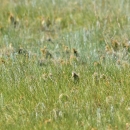About Us
Lake Thibadeau National Wildlife Refuge encompasses land reserved from public domain and 13 refuge and flowage easements on private lands.
The four main water units of this limited-interest Refuge are Thibadeau Diversion Dam, Lake Thibadeau, Grassy Lake, and Mud Lake. These wetland basins are surrounded mostly by cropland and very little native prairie remains. Of the four wetlands, only Mud Lake and the diversion unit hold any significant amounts of water. Water development projects in these drainages have significantly affected the watershed above these wetland units. Lake Thibadeau and Grassy Lake are shallow seasonal wetlands and in most years dry up, providing limited habitat for migratory birds. These two lakes are farmed every season, and Mud Lake is farmed in most years.
Our Mission
Refuge Purpose
Each unit of the National Wildlife Refuge System is established to serve a statutory purpose that targets the conservation of native species dependent on its lands and waters. All activities on those acres are reviewed for compatibility with this statutory purpose.
Lake Thibadeau National Wildlife Refuge was established on September 28, 1937 by Executive Order No. 7713 as "a refuge and breeding ground for migratory birds and other wildlife."
Our History
The history of Lake Thibadeau National Wildlife Refuge is tied to the Emergency Relief Act and the Works Progress Administration program. Created by President Franklin D. Roosevelt during the Great Depression and the Dust Bowl era of the mid-1930s, these programs were developed to employ the maximum number of people to work on public lands. During this Dust Bowl era, the country and the Government were very focused on capturing and conserving water for wildlife, particularly waterfowl, and agricultural operations. Water impoundments were popularized when the connection was made to employing out-of-work citizens to build the structures needed to impound and manage limited water resources.





